集成电路发展历史
- 格式:ppt
- 大小:2.69 MB
- 文档页数:18
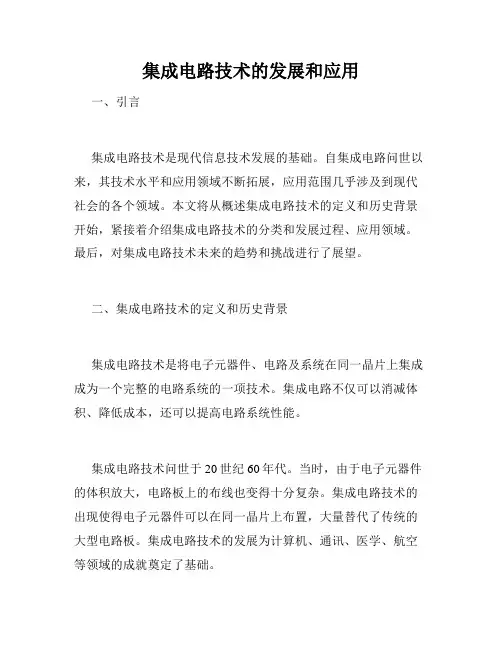
集成电路技术的发展和应用一、引言集成电路技术是现代信息技术发展的基础。
自集成电路问世以来,其技术水平和应用领域不断拓展,应用范围几乎涉及到现代社会的各个领域。
本文将从概述集成电路技术的定义和历史背景开始,紧接着介绍集成电路技术的分类和发展过程、应用领域。
最后,对集成电路技术未来的趋势和挑战进行了展望。
二、集成电路技术的定义和历史背景集成电路技术是将电子元器件、电路及系统在同一晶片上集成成为一个完整的电路系统的一项技术。
集成电路不仅可以消减体积、降低成本,还可以提高电路系统性能。
集成电路技术问世于20世纪60年代。
当时,由于电子元器件的体积放大,电路板上的布线也变得十分复杂。
集成电路技术的出现使得电子元器件可以在同一晶片上布置,大量替代了传统的大型电路板。
集成电路技术的发展为计算机、通讯、医学、航空等领域的成就奠定了基础。
三、集成电路技术的分类和发展过程集成电路技术通常可以分为数字集成电路和模拟集成电路两类。
数字集成电路采用数字电路实现各种逻辑功能,主要应用于计算机领域、嵌入式系统领域、数据通讯等领域。
数字集成电路的发展经历了MOS技术、CMOS技术、多晶硅技术等阶段,成为了数字电子产品的核心。
模拟集成电路通常用于处理连续信号,可以完成包括滤波、放大、加、减等基本运算,常常应用于音频设备、电子仪表、传感器等领域。
模拟集成电路的发展经历了个别元器件集成、压缩裂变、双极结电路、场效应晶体管技术等阶段,刺激了各种移动通信技术的快速发展。
近年来,智能卡、MEMS、生物传感器以及CMOS图像传感器等新型集成电路技术相继萌发,这些新技术的应用将不断地推动集成电路技术的发展。
四、集成电路技术的应用领域集成电路技术的应用范围非常广泛,应用领域可以涉及从消费电子到医疗卫生、从通讯到能源等几乎所有领域。
在消费电子领域,包括智能手机、平板电脑、电视、音频设备等均离不开集成电路技术。
集成电路技术的不断创新也为汽车电子领域、工业自动化领域等其他领域带来了无限的可能。
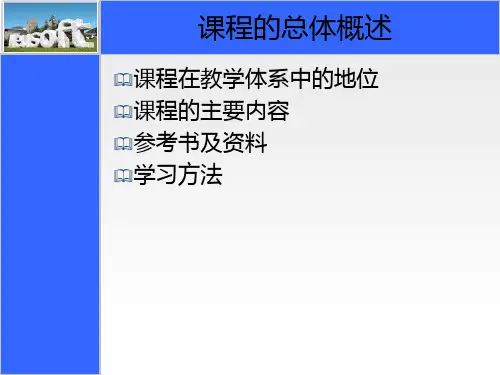
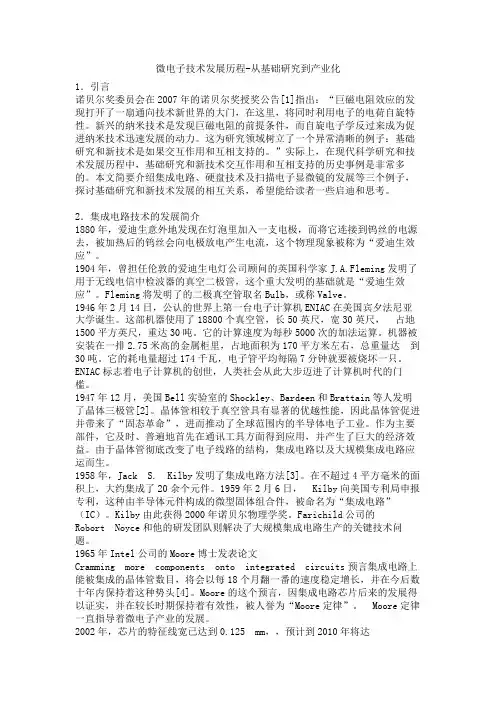
微电子技术发展历程-从基础研究到产业化1.引言诺贝尔奖委员会在2007年的诺贝尔奖授奖公告[1]指出:“巨磁电阻效应的发现打开了一扇通向技术新世界的大门,在这里,将同时利用电子的电荷自旋特性。
新兴的纳米技术是发现巨磁电阻的前提条件,而自旋电子学反过来成为促进纳米技术迅速发展的动力。
这为研究领域树立了一个异常清晰的例子:基础研究和新技术是如果交互作用和互相支持的。
”实际上,在现代科学研究和技术发展历程中,基础研究和新技术交互作用和互相支持的历史事例是非常多的。
本文简要介绍集成电路、硬盘技术及扫描电子显微镜的发展等三个例子,探讨基础研究和新技术发展的相互关系,希望能给读者一些启迪和思考。
2.集成电路技术的发展简介1880年,爱迪生意外地发现在灯泡里加入一支电极,而将它连接到钨丝的电源去,被加热后的钨丝会向电极放电产生电流,这个物理现象被称为“爱迪生效应”。
1904年,曾担任伦敦的爱迪生电灯公司顾问的英国科学家J.A.Fleming发明了用于无线电信中检波器的真空二极管,这个重大发明的基础就是“爱迪生效应”。
Fleming将发明了的二极真空管取名Bulb,或称Valve。
1946年2月14日,公认的世界上第一台电子计算机ENIAC在美国宾夕法尼亚大学诞生。
这部机器使用了18800个真空管,长50英尺,宽30英尺,占地1500平方英尺,重达30吨。
它的计算速度为每秒5000次的加法运算。
机器被安装在一排2.75米高的金属柜里,占地面积为170平方米左右,总重量达到30吨。
它的耗电量超过174千瓦,电子管平均每隔7分钟就要被烧坏一只。
ENIAC标志着电子计算机的创世,人类社会从此大步迈进了计算机时代的门槛。
1947年12月,美国Bell实验室的Shockley、Bardeen和Brattain等人发明了晶体三极管[2]。
晶体管相较于真空管具有显著的优越性能,因此晶体管促进并带来了“固态革命”,进而推动了全球范围内的半导体电子工业。
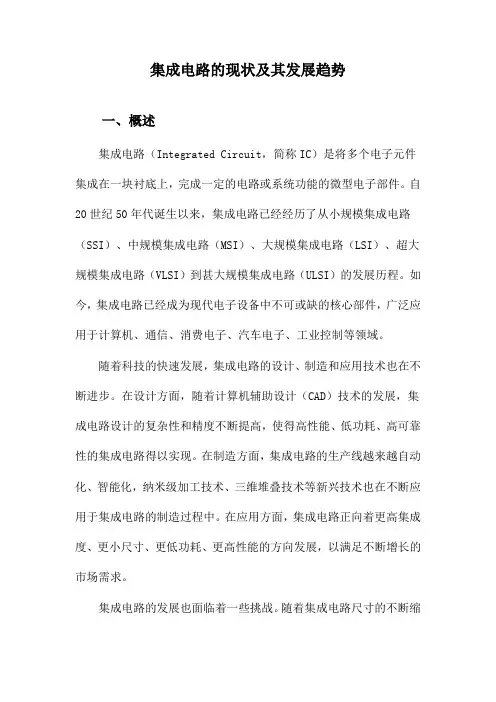
集成电路的现状及其发展趋势一、概述集成电路(Integrated Circuit,简称IC)是将多个电子元件集成在一块衬底上,完成一定的电路或系统功能的微型电子部件。
自20世纪50年代诞生以来,集成电路已经经历了从小规模集成电路(SSI)、中规模集成电路(MSI)、大规模集成电路(LSI)、超大规模集成电路(VLSI)到甚大规模集成电路(ULSI)的发展历程。
如今,集成电路已经成为现代电子设备中不可或缺的核心部件,广泛应用于计算机、通信、消费电子、汽车电子、工业控制等领域。
随着科技的快速发展,集成电路的设计、制造和应用技术也在不断进步。
在设计方面,随着计算机辅助设计(CAD)技术的发展,集成电路设计的复杂性和精度不断提高,使得高性能、低功耗、高可靠性的集成电路得以实现。
在制造方面,集成电路的生产线越来越自动化、智能化,纳米级加工技术、三维堆叠技术等新兴技术也在不断应用于集成电路的制造过程中。
在应用方面,集成电路正向着更高集成度、更小尺寸、更低功耗、更高性能的方向发展,以满足不断增长的市场需求。
集成电路的发展也面临着一些挑战。
随着集成电路尺寸的不断缩小,传统的制造方法已经接近物理极限,这使得集成电路的进一步发展变得更为困难。
同时,随着全球经济的不断发展和市场竞争的加剧,集成电路产业也面临着巨大的竞争压力。
探索新的制造技术、开发新的应用领域、提高产业竞争力成为集成电路产业未来的重要发展方向。
总体来说,集成电路作为现代电子技术的核心,其发展现状和趋势直接影响着整个电子产业的发展。
未来,随着技术的不断进步和市场的不断变化,集成电路产业将继续保持快速发展的势头,为全球经济和社会的发展做出更大的贡献。
1. 集成电路的定义与重要性集成电路(Integrated Circuit,简称IC)是一种微型电子器件或部件,采用一定的工艺,把一个电路中所需的晶体管、电阻、电容和电感等元件及布线互连一起,制作在一小块或几小块半导体晶片或介质基片上,然后封装在一个管壳内,成为具有所需电路功能的微型结构。
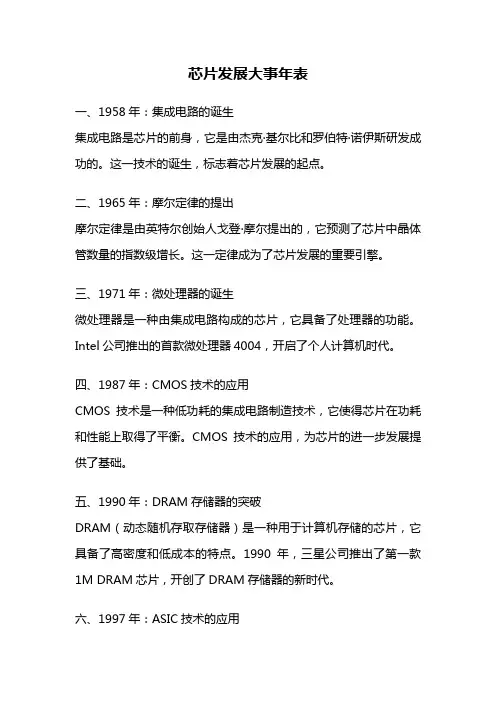
芯片发展大事年表一、1958年:集成电路的诞生集成电路是芯片的前身,它是由杰克·基尔比和罗伯特·诺伊斯研发成功的。
这一技术的诞生,标志着芯片发展的起点。
二、1965年:摩尔定律的提出摩尔定律是由英特尔创始人戈登·摩尔提出的,它预测了芯片中晶体管数量的指数级增长。
这一定律成为了芯片发展的重要引擎。
三、1971年:微处理器的诞生微处理器是一种由集成电路构成的芯片,它具备了处理器的功能。
Intel公司推出的首款微处理器4004,开启了个人计算机时代。
四、1987年:CMOS技术的应用CMOS技术是一种低功耗的集成电路制造技术,它使得芯片在功耗和性能上取得了平衡。
CMOS技术的应用,为芯片的进一步发展提供了基础。
五、1990年:DRAM存储器的突破DRAM(动态随机存取存储器)是一种用于计算机存储的芯片,它具备了高密度和低成本的特点。
1990年,三星公司推出了第一款1M DRAM芯片,开创了DRAM存储器的新时代。
六、1997年:ASIC技术的应用ASIC(专用集成电路)是一种根据特定需求定制的芯片,它具备了高性能和低功耗的特点。
ASIC技术的应用,为电子产品的不断创新提供了支撑。
七、2000年:SOC技术的兴起SOC(片上系统)是一种将多个功能模块集成在一颗芯片上的技术,它大大简化了电子产品的设计和生产流程。
SOC技术的兴起,为信息产业的快速发展奠定了基础。
八、2003年:无线通信芯片的发展无线通信芯片是一种用于无线通信设备的芯片,它具备了高速传输和稳定连接的特点。
2003年,高通推出了首款3G无线通信芯片,推动了移动通信的普及和发展。
九、2010年:ARM架构的崛起ARM架构是一种低功耗的处理器架构,它被广泛应用于移动设备和嵌入式系统。
ARM架构的崛起,改变了传统的处理器格局,推动了智能手机等移动设备的快速发展。
十、2017年:人工智能芯片的崭露头角人工智能芯片是一种专门用于加速人工智能计算的芯片,它具备了高性能和低功耗的特点。
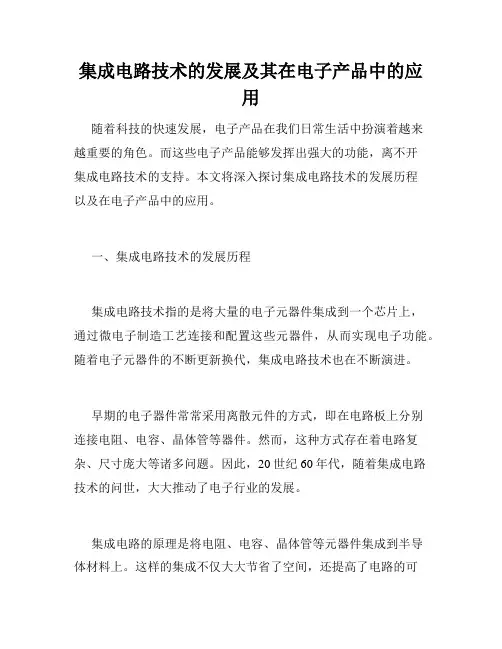
集成电路技术的发展及其在电子产品中的应用随着科技的快速发展,电子产品在我们日常生活中扮演着越来越重要的角色。
而这些电子产品能够发挥出强大的功能,离不开集成电路技术的支持。
本文将深入探讨集成电路技术的发展历程以及在电子产品中的应用。
一、集成电路技术的发展历程集成电路技术指的是将大量的电子元器件集成到一个芯片上,通过微电子制造工艺连接和配置这些元器件,从而实现电子功能。
随着电子元器件的不断更新换代,集成电路技术也在不断演进。
早期的电子器件常常采用离散元件的方式,即在电路板上分别连接电阻、电容、晶体管等器件。
然而,这种方式存在着电路复杂、尺寸庞大等诸多问题。
因此,20世纪60年代,随着集成电路技术的问世,大大推动了电子行业的发展。
集成电路的原理是将电阻、电容、晶体管等元器件集成到半导体材料上。
这样的集成不仅大大节省了空间,还提高了电路的可靠性和稳定性。
1960年代中期,由美国计算机先驱杰克·基尔比发明的集成电路,被视为集成电路技术的里程碑。
随后,全球范围内的科学家和工程师纷纷投身于集成电路技术的研究与应用。
二、集成电路技术的应用领域集成电路技术的应用范围非常广泛,几乎涵盖了所有的电子设备。
接下来,我们将重点介绍集成电路技术在通信、计算机和消费电子产品中的应用。
1. 通信领域通信领域是集成电路技术的重要应用领域之一。
无线通信如今已经成为现代社会的重要组成部分,而集成电路技术是实现无线通信的关键。
在手机、卫星通信、无线网络等设备中,集成电路被广泛应用。
通过集成电路技术,可以实现复杂的信号处理和调制解调功能,从而保证通信的可靠性和高效性。
2. 计算机领域计算机是另一个集成电路技术大显身手的领域。
早期的计算机由庞大的真空管构成,占据了大量空间并且功耗高。
而通过集成电路技术,可以将这些元器件集成到一个芯片上,大大提高计算机的性能和可靠性。
如今的计算机中,中央处理器、内存、显示芯片等都是通过集成电路技术实现的。
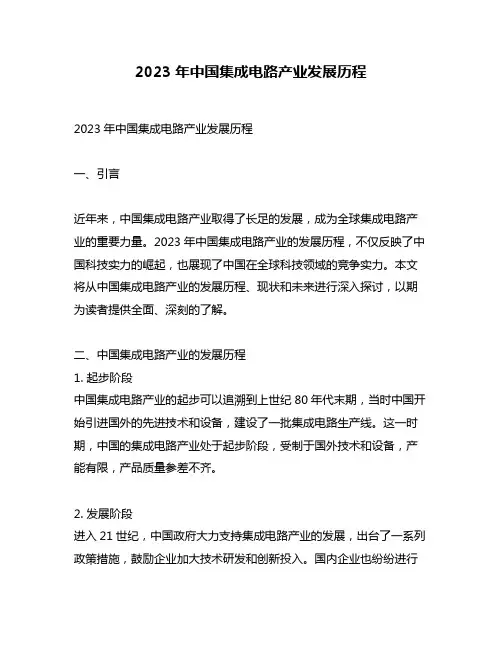
2023年中国集成电路产业发展历程2023年中国集成电路产业发展历程一、引言近年来,中国集成电路产业取得了长足的发展,成为全球集成电路产业的重要力量。
2023年中国集成电路产业的发展历程,不仅反映了中国科技实力的崛起,也展现了中国在全球科技领域的竞争实力。
本文将从中国集成电路产业的发展历程、现状和未来进行深入探讨,以期为读者提供全面、深刻的了解。
二、中国集成电路产业的发展历程1. 起步阶段中国集成电路产业的起步可以追溯到上世纪80年代末期,当时中国开始引进国外的先进技术和设备,建设了一批集成电路生产线。
这一时期,中国的集成电路产业处于起步阶段,受制于国外技术和设备,产能有限,产品质量参差不齐。
2. 发展阶段进入21世纪,中国政府大力支持集成电路产业的发展,出台了一系列政策措施,鼓励企业加大技术研发和创新投入。
国内企业也纷纷进行自主研发,加大技术改造力度。
随着发展阶段的到来,中国的集成电路产业逐渐走向成熟,拥有了相对完善的产业链和技术体系。
3. 竞争与突破随着国际市场的竞争日益激烈,中国的集成电路企业不断加大技术研发和市场拓展力度,努力提升自身的核心竞争力。
一些企业甚至在先进制程、存储器、芯片设计等领域取得了重大突破,推动了中国集成电路产业的整体发展。
4. 成果丰硕到了2023年,中国集成电路产业已经取得了一系列斐然成果:在12nm、7nm等先进制程领域实现了突破,部分企业的芯片产品性能达到了国际领先水平;存储器、传感器、模拟集成电路等领域也取得了显著成绩,进一步巩固了中国在全球集成电路产业中的地位。
中国集成电路产业的整体市场规模也持续扩大,成为全球集成电路产业中不可忽视的力量。
三、中国集成电路产业的现状1. 技术水平中国集成电路产业在技术水平上已经取得了长足的进步,部分领域甚至达到了国际先进水平。
但与国际巨头相比,仍存在一定的差距,尤其是在先进制程和芯片设计等领域。
2. 产业链完善中国的集成电路产业链日益完善,涵盖了芯片设计、制造、封测等多个环节。
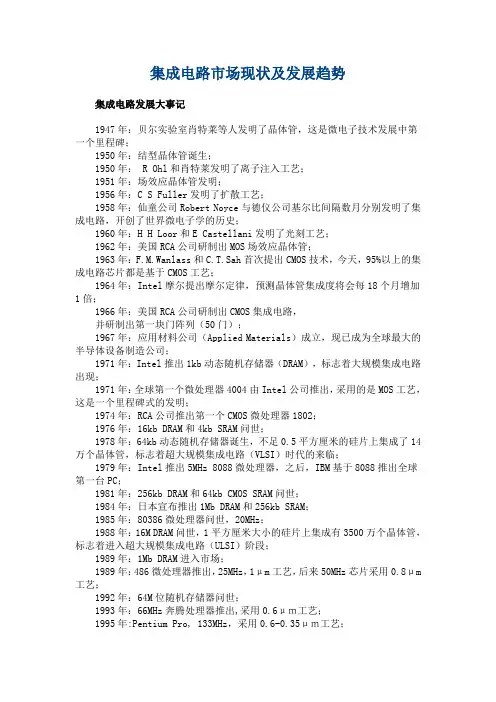
集成电路市场现状及发展趋势集成电路发展大事记1947年:贝尔实验室肖特莱等人发明了晶体管,这是微电子技术发展中第一个里程碑;1950年:结型晶体管诞生;1950年: R Ohl和肖特莱发明了离子注入工艺;1951年:场效应晶体管发明;1956年:C S Fuller发明了扩散工艺;1958年:仙童公司Robert Noyce与德仪公司基尔比间隔数月分别发明了集成电路,开创了世界微电子学的历史;1960年:H H Loor和E Castellani发明了光刻工艺;1962年:美国RCA公司研制出MOS场效应晶体管;1963年:F.M.Wanlass和C.T.Sah首次提出CMOS技术,今天,95%以上的集成电路芯片都是基于CMOS工艺;1964年:Intel摩尔提出摩尔定律,预测晶体管集成度将会每18个月增加1倍;1966年:美国RCA公司研制出CMOS集成电路,并研制出第一块门阵列(50门);1967年:应用材料公司(Applied Materials)成立,现已成为全球最大的半导体设备制造公司;1971年:Intel推出1kb动态随机存储器(DRAM),标志着大规模集成电路出现;1971年:全球第一个微处理器4004由Intel公司推出,采用的是MOS工艺,这是一个里程碑式的发明;1974年:RCA公司推出第一个CMOS微处理器1802;1976年:16kb DRAM和4kb SRAM问世;1978年:64kb动态随机存储器诞生,不足0.5平方厘米的硅片上集成了14万个晶体管,标志着超大规模集成电路(VLSI)时代的来临;1979年:Intel推出5MHz 8088微处理器,之后,IBM基于8088推出全球第一台PC;1981年:256kb DRAM和64kb CMOS SRAM问世;1984年:日本宣布推出1Mb DRAM和256kb SRAM;1985年:80386微处理器问世,20MHz;1988年:16M DRAM问世,1平方厘米大小的硅片上集成有3500万个晶体管,标志着进入超大规模集成电路(ULSI)阶段;1989年:1Mb DRAM进入市场;1989年:486微处理器推出,25MHz,1μm工艺,后来50MHz芯片采用0.8μm 工艺;1992年:64M位随机存储器问世;1993年:66MHz奔腾处理器推出,采用0.6μm工艺;1995年:Pentium Pro, 133MHz,采用0.6-0.35μm工艺;1997年:300MHz奔腾Ⅱ问世,采用0.25μm工艺;1999年:奔腾Ⅲ问世,450MHz,采用0.25μm工艺,后采用0.18μm工艺;2000年: 1Gb RAM投放市场;2000年:奔腾4问世,1.5GHz,采用0.18μm工艺;2001年:Intel宣布2001年下半年采用0.13μm工艺。
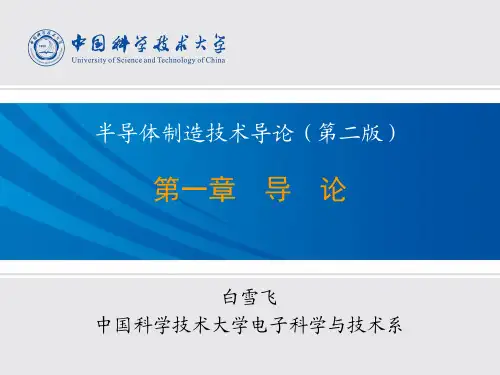

集成电路技术的发展与趋势一、引言自从第一个集成电路IC问世以来,集成电路技术就不断在发展。
在这几十年间,我们见证了集成电路技术从部件级、门电路级、逻辑电路级,到现在大规模集成、超大规模集成的演变。
集成度越来越高,功能越来越强大,越来越多的应用市场涌现出来。
本文将从发展历程、发展趋势两个方面进行介绍。
二、发展历程集成电路技术的发展可以分为以下阶段:1. 部件级:1958年,杰克·基尔比联合展开任职于德州仪器公司(Texas Instruments)的工程师建造了第一片基于硅的晶体管。
2. 门电路级:20 世纪 60 年代,集成电路的发明使得门电路成为了联系数字电路理论和实践的桥梁。
3. 逻辑电路级:20 世纪 70 年代,高效的 LSI 设计流程、优秀的EDA 工具+1、越来越成熟的制造工艺以及全新的计算机软、硬件技术实现了大规模的逻辑电路集成。
4. 大规模集成:20世纪80年代末-90年代初,CMOS工艺的成熟,使得集成电路的尺寸继续缩小,并增加了逻辑门的数量。
5. 超大规模集成:21世纪至今,CMOS8nm以下制程的问世,航空航天、射频、生物医学等领域对芯片尺寸、功耗、带宽、操作速度等多方面提出了更高的要求,促使集成电路技术的发展又迈入新的阶段。
三、发展趋势1. 高速化:在高速通信和计算机处理上,对芯片速度的要求越来越高,这对芯片技术提出了更高的要求。
芯片的时钟速度已经进入 GHz 级别,未来还要朝更高速度的方向发展。
2. 低功耗化:低功耗技术正在逐步发展,未来芯片将更好地应用于物联网、智能家居、智能穿戴和汽车等领域。
在低功耗技术方面,芯片制造商使用FinFET 级别的工艺制造芯片,进一步降低功耗,提高芯片运转稳定性。
3. 集成度的提高:集成度不断提高,更多的功能能够实现在一个芯片上,从而节省了空间和能量。
这也有助于开发更小、更强大的产品。
4. 小型化:印刷电路板(PCB)又不仅仅是连接各种元器件的线路板。

大规模集成电路与超大规模集成电路一、引言1.1 背景介绍1.2 任务意义二、大规模集成电路2.1 定义与特点2.2 历史发展2.3 优势与应用2.3.1 优势2.3.2 应用三、超大规模集成电路3.1 定义与特点3.2 历史发展3.3 优势与应用3.3.1 优势3.3.2 应用四、大规模集成电路与超大规模集成电路的比较4.1 基本概念比较4.2 技术差异比较4.3 性能差异比较五、未来发展趋势5.1 小型化与高性能5.2 芯片整合与功能增强5.3 应用领域拓展六、总结一、引言1.1 背景介绍近年来,随着科技的不断进步和人们对高效便捷的需求,集成电路技术得到了迅猛发展。
大规模集成电路(Large Scale Integrated Circuit,简称LSI)和超大规模集成电路(Very Large Scale Integrated Circuit,简称VLSI)作为其中两个重要的分支,被广泛应用于各个领域。
1.2 任务意义本文旨在对大规模集成电路和超大规模集成电路进行全面深入的探讨,比较它们的特点、优势以及应用领域,探讨未来发展趋势,为读者对集成电路技术有更深入的了解和认识。
二、大规模集成电路2.1 定义与特点大规模集成电路是指将数百个或数千个晶体管、电阻和电容等离散元件集成在一个芯片上的集成电路。
它的特点是规模较大,晶体管数量在1000到1亿个之间,单个芯片上能实现多种不同功能。
2.2 历史发展大规模集成电路的发展始于20世纪60年代。
随着工艺技术的进步和封装方式的改善,集成电路的规模不断扩大。
在过去几十年中,大规模集成电路在计算机、通信、军事等领域得到广泛应用。
2.3 优势与应用2.3.1 优势•高性能:大规模集成电路的高集成度使得电路运行速度更快,性能更强。
•低功耗:相比于离散元件电路,大规模集成电路通过集成化可以减少功耗。
•节省空间:大规模集成电路可以集成多个功能模块,减少了电路板的空间占用。
集成电路技术的发展与应用随着时代的进步和科技的不断创新,集成电路技术也在不断的发展和应用。
集成电路技术是指将多个电子器件和电路组合在一个芯片上,成为一种高度集成化的电子器件。
这种技术的出现,极大地加快了电器的性能和可靠性,也大大的缩小了电子元器件的体积和重量,让人们的生活更加便捷、优美、高效,并且给了我们以更多的可能性。
一、集成电路技术的历史与发展集成电路技术可以追溯到20世纪60年代,当时许多人都在尝试着将半导体器件在单一芯片上进行组合和集成。
最初的集成电路只能够由几个晶体管组成,随后的集成电路每个芯片上可以集成数百个晶体管,然后迅速发展到数千个晶体管。
如今,集成电路的最新发展,一个芯片上可以集成数十亿个晶体管,这是当初也根本难以想象的。
随着电子科技的发展,集成电路技术的性能逐渐被提高,在电子产品中得到了广泛应用,成为了电子工业中不可或缺的一部分。
二、集成电路技术的应用随着科技的日益进步和社会经济的快速发展,集成电路在各个领域应用越来越广泛,我们的生活离不开它。
现如今,集成电路技术已经在电脑、手机、平板电视、汽车、通讯、军事、医疗等各个领域得到了广泛的应用。
1.电子产品:集成电路技术的最常见的应用莫过于电子产品了,包括手机、平板电脑、电脑、电视等产品都离不开集成电路技术。
当今的手机已经实现了跨越式的进步,用高集成度的芯片,电池寿命已成倍的增加,20多年前手机里的功能全部集成在了一个芯片内。
2.军事:在军事领域,集成电路技术得到了广泛的应用,这是因为在军事领域,芯片的性能要求极高。
集成电路可以在导弹、卫星、雷达、无人机等高光学强度和电子干扰的极端环境下正常工作。
3.汽车:在汽车领域中,许多汽车制造商都使用集成电路技术来提高汽车的性能和降低成本,如实现自动驾驶就依靠了集成电路技术。
三、集成电路技术的未来在未来,集成电路技术将继续发展和应用。
未来的芯片要更快速,更强大,更高效。
随着新型材料的应用,集成电路的性能将得到更大的提高。
集成电路的发展史主讲单位: CECC实验室主讲人: 陈田主要听众: 驰创电子世界半导体发展史1947Bell Labs invents transistor on December 23. Its first commercial use is in products for the hearing impaired.1948Bell Labs grows single germanium crystal, offering more uniform electrical conduction and fewer defects.1949International Rectifier ships first commercial semiconductor devices. First chess-playing machine built by Claude Shannon.1950The grown junction transistor becomes the first devise with enough predictability and dependability to use ina range of consumer goods.1951Univac delivers a computer to the census bureau.1952Texas Instruments (TI) enters the semiconductor business.Motorola establishes a solid state electronics R&D lab in Phoenix to capitalize on the recent inventions of the transistor.IBM unveils the 701, the first computer to store electronic programs.1953Motorola applies for its first semiconductor related patent to develop low cost transistors for audio power stages of radio communication receivers and auto radios.1954Transistor radio, developed by Texas Instruments and sold by the IDEA Co. of Ohio, hits the market.TI develops the silicon junction transistor. Its higher melting point makes it ideal for space and military use.Bell Labs introduces an all-transistor computer.1955Bells Labs introduces photoresist, a technique still used today to mass produce batches of identical circuits.1956General Electric introduces first solid-state silicon switches.1957"Explorer," the first U.S. orbiting satellite, uses transistor technology.Fairchild Semiconductor becomes the first company to work exclusively with silicon.The semiconductor industry surpasses $100 million in sales for the first time.1958Cray introduces all-transistor supercomputer.Texas Instruments’Jack Kilby demonstrates first integrated circuit (IC).U.S. Air Force incorporates semiconductors in Minutemen Missile design. The Pentagon and NASA quickly become two of the industry’s major customers.1959National Semiconductor opens in Danbury, Connecticut.Fairchild Semiconductor’s Robert Noyce commercializes process for making ICs.1960Digital Equipment Corp. produces the first mini-computer, known as the PDP-1.AT&T invents the first modem.1961TI builds the first integrated circuit computer.Motorola is the first to use the epitaxial method, developed by Bell Labs, to mass produce semiconductors.This low-cost technique made the auto alternator a reasonably priced and more durable replacement for the auto generator.Motorola is the first to use the epitaxial method, developed by Bell Labs, to mass produce semiconductors.1962Motorola Corp. introduces the first transistorized walkie-talkie known as the Handi-Talkie HT-200.1963Companies begin shipping integrated circuits.1964Texas Instruments provides the first ICs used in a consumer product, a hearing aid.IBM unveils the System/360, the first family of computers.The semiconductor industry surpasses $1 billion in sales for the first time.1965Gordon Moore predicts exponential growth (biannual doubling) in chip power. It becomes known as "Moore’s Law.“1966Hewlett-Packard introduces the first solid-state oscilloscope. Silicon technology makes the key electronics test instrument lighter and smaller.1967Texas Instruments invents handheld calculator.Motorola introduces the Quasar line of all-transistor color TVs.1968Andy Grove, Robert Noyce and Gordon Moore create Intel Corp. That same year Intel introduces the first 1k RAM.1969Apollo mission lands first men on the moon aided by a variety of semiconductors.Advanced Micro Devices incorporates with $100,000.1970Intel introduces DRAM. This chip becomes the memory component of computers and other electronics, anda source of trade strife when the U.S. later accuses the Japanese of "dumping," a term for selling productsbelow market price.1971Intel invents SRAM and EPROM and introduces microprocessors, which enable the "brains" of a computer to be on one chip for the first time.Shortly after Intel introduces the 4004, TI introduces a single-chip microprocessor.Alan Shugart of IBM invents the floppy disk.1972Hewlett-Packard introduces the first scientific pocket calculator. It sent slide rule manufacturers out ofbusiness.1973Price scanner introduced. The UPC symbol becomes ubiquitous.Motorola introduces the portable cellular radio-telephone, the precursor to the modem cell phone.1974Bell Labs invents and IBM uses electron beams in chip production.Zilog introduces the Z-80 microprocessor.Motorola introduces the 6800 microprocessor.Xerox invents the built-in mouse.1975Altair, the first personal computer, goes on market.Bill Gates and Paul Allen launch Microsoft.1976Steve Wozniak and Steve Jobs found Apple Computer.The first word-processing program, Electric Pencil, is unveiled.1977U.S. semiconductor company pioneers form Semiconductor Industry Association.Monolithic Memories Inc. invents field programmable logic, the first logic devise that can be programmed by users.SIA takes over administration of the Semiconductor Trade Statistics Program (STSP); now known as the World Semiconductor Trade Statistics (WSTS).1978SIA forms 6 major committees on: trade policy, education, worker safety, trade statistics, investment and capital formation, and a technical advisory committee.Micron opens in Boise, Idaho as a semiconductor design consulting firm.TI introduces the first single-chip speech synthesizer. Its first use: The Speak & Spell Toy.1979Motorola introduces the 16-bit microprocessor. Its two-million-calculations-per-second capability is adopted by Apple Computer for its Macintosh PCs.Bell Labs introduces a single-chip digital signal processor that performs speech compression, filtering, error corrections and other functions much faster and better than multiple chips.The semiconductor industry surpasses $10 billion in sales.1980SIA commissions a major research study by Chase Financial Policy on the cost of capital in thesemiconductor industry; which finds U.S. firms facing significant disadvantages compared to theirinternational competitors.IBM enters the PC business with a line of desktop PCs, later to become the single largest use formicroprocessors.Motorola introduces first pager to incorporate a microprocessor,allowing longer battery life and the ability to have more pagers on a network.1981In response to SIA advocacy efforts, the U.S. and Japan lower semiconductor tariffs to 4.2 percent.Hewlett-Packard introduces the first scientific pocket calculator. It sent slide rule manufacturers out ofbusiness.LSI Logic introduces gate array, the first semi-custom chip.SIA helps gain approval of the federal R&D tax credit.1982SIA forms Semiconductor Research Corp. (SRC) to plan, direct and fund pre-competitive silicon research programs at major universities.Xilinx invents field programmable gate arrays, chips that can be customized by the user.VLSI introduces standard cells, predefined circuit elements for custom chips.1983Motorola’s first cellular phone comes to market.AMD introduces INT. STD. 1000.SIA efforts lead to creation of U.S. Japan Working Group on High Tech to resolve trade issues.The SIA Japan Chapter, made up of senior level executives from SIA member companies doing business in Japan, is created to provide and industry-to-industry dialogue between Japanese and American companies.1984Chip Protection Act becomes law, creating the first new form of intellectual property protection in the United States since the 19th century.The SIA-supported Trade and Tariff Act of 1984 becomes law, authorizing negotiation of high tech trade issues and tariff elimination.Congress revises antitrust laws to allow joint R&D consortia.IBM develops a one-million bit RAM.Anti-lock brakes begin using microcontrollers.Apple introduces the Macintosh computer.1985U.S. and Japanese governments agree to eliminate tariffs on semiconductors. SIA files petition with U.S.government, citing unfair Japanese market barriers.Intel drops out of DRAM business.1986At the urging of SIA, U.S. and Japan sign agreement to end dumping practices and open Japan’s market; yet nine of eleven U.S. DRAM manufacturers leave market, and Japan overtakes U.S. as the world’s leading semiconductor producer.Japanese firms lose $4 billion in quest for semiconductor dominance.Compaq unveils 386-based PCs.Bell Labs introduces neural network chips that mimic the way some brain cells retrieve stored information and solve problems.1987SIA forms SEMATECH, a consortium of chip manufacturers dedicated to improving manufacturingtechnology.At the urging of SIA, U.S. imposes $300 million in trade sanctions against Japan for failing to comply with antidumping agreement.U.S. EPROM manufacturers regain worldwide lead; next to DRAM, EPROMs are most critical commodity product.1988With the SIA’s encouragement, the U.S. Congress approves the formation of the National AdvisoryCommittee on Semiconductors (NACS).Reduced Instruction Set Chip (RISC) technology becomes available commercially, allowing faster, less memory-intensive programming options.After meeting with the SIA, the Electronic Industries Association of Japan (EIAJ) forms the Users Committee of Foreign Semiconductors (UCOM) in an effort to provide greater access for foreign suppliers in the Japan market.The U.S. semiconductor industry reinforces its commitment to the Japan market by opening an SIA office in Tokyo, Japan.1989The SIA and EIAJ establish a consumer task force to discuss methods to increase foreign chip sales to Japanese consumer equipment makers.SIA commissions a three-year $3.5 million reproductive health study to determine if some chemicals used in chip plants cause health problems.Members of the SIA’s Health and Safety Committee and EIAJ initiate annual meetings to discusssemiconductor safety and environmental issues. These meetings are the precursor to the international ESH conferences, beginning in 1984.1990SIA’s Technology Strategy Committee is created to track industry technology requirements and makerecommendations to the industry.Panasonic Palmcorder is introduced using LSI Logic chips. LSI was the first U.S. company to design a chip specifically for a Japanese company’s consumer product.Internet use tops 100,000.1991Japan & U.S. announce new trade agreement committing Japan to open its market to foreignsemiconductors and providing a strong deterrent to dumping.SIA is presented the prestigious "E Award" by U.S. Secretary of Commerce Robert Mosbacher for theassociation’s outstanding efforts to increase American exports.1992SIA’s reproductive health study recommends phasing out some chemicals used in manufacturing chips.Technology experts gather to design a 15-year roadmap for national semiconductor research needs; known as the National Technology Roadmap.Microsoft introduces Windows 3.1.1993Through the efforts led by the SIA, U.S. overtakes Japan in worldwide chip sales.IBM and Motorola introduce RISC chip for PCs.Harris Corp. introduces Monster Power ICs (MCT). They help motorized products from refrigerators to jet fighters operate more efficiently.1994The SIA succeeds in achieving Congressional approval of the Uruguay Round of multilateral tradenegotiations that establishes the World Trade Organization (WTO), lowers semiconductor tariffs, strengthens intellectual property protection, and maintains effective antidumping provisions.U.S. Labor Department ranks the semiconductor industry as America’s second safest, reflecting a dramatic reduction in work-related injury and illness rates among domestic semiconductor workers.The semiconductor industry surpasses $100 billion sales.1995Foreign share of Japanese market exceeds 20 percent for the first time.SIA explores the rapidly growing Chinese market in its document,"Semiconductors in China: DefiningAmerican Interest."The SIA and EIAJ jointly announce the Emerging Applications Cooperative Project and other efforts tostimulate major design-ins and other business opportunities in Japan for foreign semiconductormanufacturers.1996U.S. fabrication facility growth explodes as chips become increasingly prevalent in new consumer products.High-end chips make computer networking, telephone communications and internet connections faster and smarter.U.S. and Japan approve new trade agreement on semiconductors as foreign share in Japan approaches 30 percent. Agreement calls for the establishment of the World Semiconductor Council (WSC).AT&T spins off Lucent, the portion of the telephone giant once known as Bell Labs.SIA members negotiate memorandum on global warming with U.S. Environmental Protection Agency.Companies agree to continue reducing their usage of ozone-depleting chemicals.1997SIA unveils the Focus Center Program. The new consortium is designed to tackle technology roadblocks by focusing on long-term research (eight years and beyond).A new edition of the National Technology Roadmap is released worldwide.The SIA, working with the U.S. government and 38 other countries, accounting for more than 92 percent of the global trade and information technology products, creates the Information Technology Agreement (ITA).The ITA eliminates duties on chips, computers and telecommunications equipment.1998SIA creates a Workforce Strategy Committee to address the critical need of an increased and educated workforce.The SIA and its coalition partners successfully lobbies to secure passage of the "American Competitiveness and Workforce Improvement Act of 1998," which nearly doubles the number of foreign engineers andscientists whole will be eligible to work for technology companies in the U.S.New SIA study shows that the semiconductor industry is the No. 1driver ofgrowth for the U.S. economy, providing jobs for 260,000 people and creating an additional 1.4 millions jobs for people who provide goods and services for the industry.U.S. chip companies command more than 50 percent of the global market.The SIA and a coalition of high technology companies successfully lobby to secure the Securities Litigation Uniform Standard Act of 1998, which makes federal court the sole venue for hearing class action suits on securities fraud allegations against companies with rapid fluctuations in stock prices and eliminates frivolous lawsuits in state courts.The WSC receives the 1998 Climate Protection Award from the U.S.Environmental Protection Agency.19991999became known as the "year of recovery" for the semiconductor industry. Sales shift the demand from PCs to communications products.The SIA and member companies lobby extensively to achieve the top 1999 legislative priority with thepassage of the Y2K bill to limit frivolous lawsuits against American businesses and industries.The 1st two Focus Centers become fully operational at UC Berkeley andGeorgia Tech.The U.S. and China agreed to the terms of China’s accession to the WTO.SIA establishes a presence in China by joining other electronic associations in the U.S. InformationTechnology Office in Beijing (USITO).SIA successfully lobbies for an R&D tax credit extension for an additional five years.2000In 2000, the technology roadmap becomes international and the 2000 International Roadmap for Semiconductors (ITRS) is released.Worldwide semiconductor sales exceed $200 billion for the first time insemiconductor history.The semiconductor industry becomes recognized by the US Bureau of Labor and ranked 2nd in the nation for the lowest injury and illness rate out of 208 durable goods manufacturing industries.The SIA lobbies extensively for passage of Permanent Trade Relations legislation with China in order to ensure that China lowers its tariffs on semiconductors, respects intellectual property rights, allows semiconductorcompanies to sell directly to China without using middlemen, and eliminates investment barriers, among other measures.SIA Board funds a major initiative to increase the number of undergraduate engineers interested insemiconductor careers.SIA establishes a Scientific Advisory Committee (SAC), an independent panel commissioned to review existing industry data to address allegations of cancer risks among semiconductor employees.2001China formally joined the WTO on terms advocated by the SIA.Two additional Focus Centers were created: "Materials, Structures and Devices" and Circuits, Systems and Software."The National Science Foundation sees a 8 percent increase in funding.As a result of SIA’s efforts, China begins to provide intellectual property protection for registered IC designs and eliminate its tariffs on semiconductors.2002SIA successfully lobbies Congress to appropriate $10.5 billion for science and technology at the DefenseDepartment, a 12 percent increase over the prior year, along with a 2 percent increase for the Department of Energy’s Science Office.SIA is instrumental in helping to assure that harmful legislation requiring expensing of employee stock options or minimum holding periods for executive stock grants is not enacted.SIA scores a major victory in streamlining U.S. export controls when the President eliminates MTOPS controls on commercial export of microprocessors.SIA helps secure Congressional passage of a $25 million technology talent expansion program that SIA had strongly advocated.SIA embarks on Worker Health Project to determine and further minimize any potential risks to our employees.SIA successfully advocated Congressional approval of Trade Promotion Authority (TPA).SIA releases the 2002 International Technology Roadmap for Semiconductors (ITRS)SIA publishes a commemorative book, Beyond Imagination, chronicling the semiconductor industry since its inception.SIA honors Dr. Gordon Moore with its first-ever Lifetime Achievement Award.2000In 2000, the technology roadmap becomes international and the 2000 International Roadmap for Semiconductors (ITRS) is released.Worldwide semiconductor sales exceed $200 billion for the first time insemiconductor history.The semiconductor industry becomes recognized by the US Bureau of Labor and ranked 2nd in the nation for the lowest injury and illness rate out of 208 durable goods manufacturing industries.The SIA lobbies extensively for passage of Permanent Trade Relations legislation with China in order to ensure that China lowers its tariffs on semiconductors, respects intellectual property rights, allows semiconductorcompanies to sell directly to China without using middlemen, and eliminates investment barriers, among other measures.SIA Board funds a major initiative to increase the number of undergraduate engineers interested insemiconductor careers.SIA establishes a Scientific Advisory Committee (SAC), an independent panel commissioned to review existing industry data to address allegations of cancer risks among semiconductor employees.2001China formally joined the WTO on terms advocated by the SIA.Two additional Focus Centers were created: "Materials, Structures and Devices" and Circuits, Systems and Software."The National Science Foundation sees a 8 percent increase in funding.As a result of SIA’s efforts, China begins to provide intellectual property protection for registered IC designs and eliminate its tariffs on semiconductors.2002SIA successfully lobbies Congress to appropriate $10.5 billion for science and technology at the DefenseDepartment, a 12 percent increase over the prior year, along with a 2 percent increase for the Department of Energy’s Science Office.SIA is instrumental in helping to assure that harmful legislation requiring expensing of employee stock options or minimum holding periods for executive stock grants is not enacted.SIA scores a major victory in streamlining U.S. export controls when the President eliminates MTOPS controls on commercial export of microprocessors.SIA helps secure Congressional passage of a $25 million technology talent expansion program that SIA had strongly advocated.SIA embarks on Worker Health Project to determine and further minimize any potential risks to our employees.SIA successfully advocated Congressional approval of Trade Promotion Authority (TPA).SIA releases the 2002 International Technology Roadmap for Semiconductors (ITRS)SIA publishes a commemorative book, Beyond Imagination, chronicling the semiconductor industry since its inception.SIA honors Dr. Gordon Moore with its first-ever Lifetime Achievement Award.中国半导体发展史1947年,美国贝尔实验室发明了半导体点接触式晶体管,从而开创了人类的硅文明时代。